Friday Feb. 22, 2008
Quiz #1 has been graded and was returned in class. Be sure to
carefully check your quiz
for errors.
The 1S1P Topic #2 reports were returned in class. The Topic #3
reports should be graded and returned sometime next week. A new
1S1P assignment will be made soon, perhaps as early as next week.
The Optional Assignment #2 papers were returned today.
Chapter 2
is concerned with energy, temperature, heat, energy transport, and
energy
balance between the earth, atmosphere, and space.
It is easy to
lose sight of the main concepts because there are so many
details. The following (found on pps 43&44 in the photocopied
Class Notes) is meant to introduce some of what we will be covering in
class from Chapter 2.
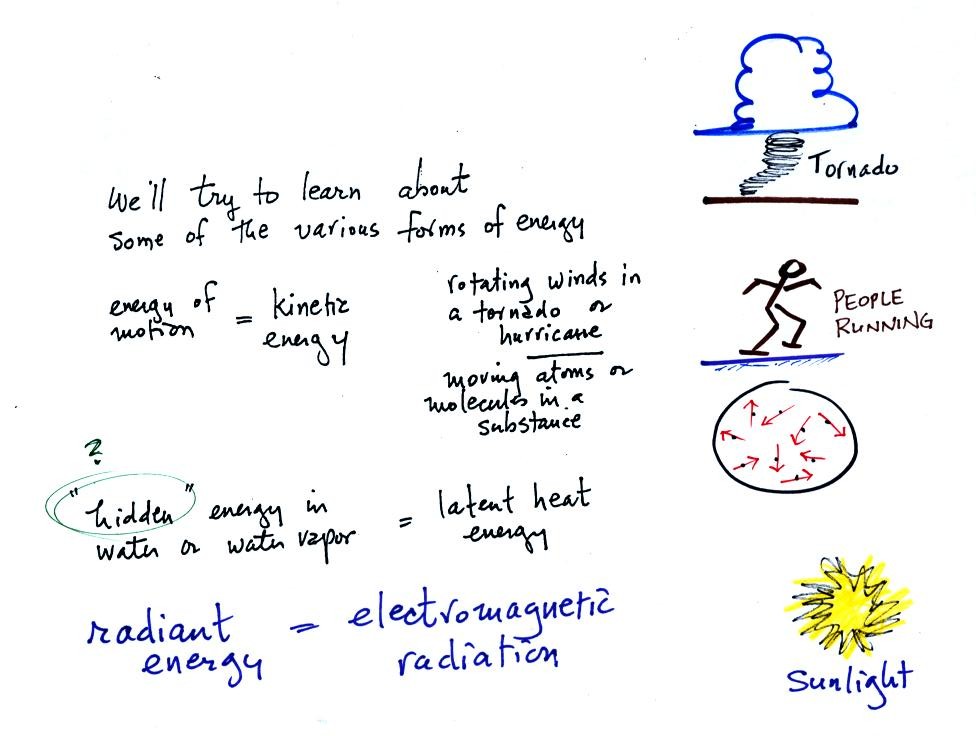
We will learn the names of several different types or forms of
energy. Kinetic energy is energy of motion. Some examples are mentioned
and sketched above. It is a relatively easy to visualize and
understand form of energy.
Latent heat energy is perhaps the most underappreciated and most
confusing type of energy. The word latent refers to energy that is
hidden in water and water vapor. The hidden energy emerges when
water vapor condenses or water freezes.
Radiant energy is a very important form of energy that was for some
reason left off the original list. Sunlight is an example of
radiant energy that we can see and feel (you feel warm when you stand
in sunlight). There are many types of radiant energy
that are invisible.
Four energy transport
processes are listed below.
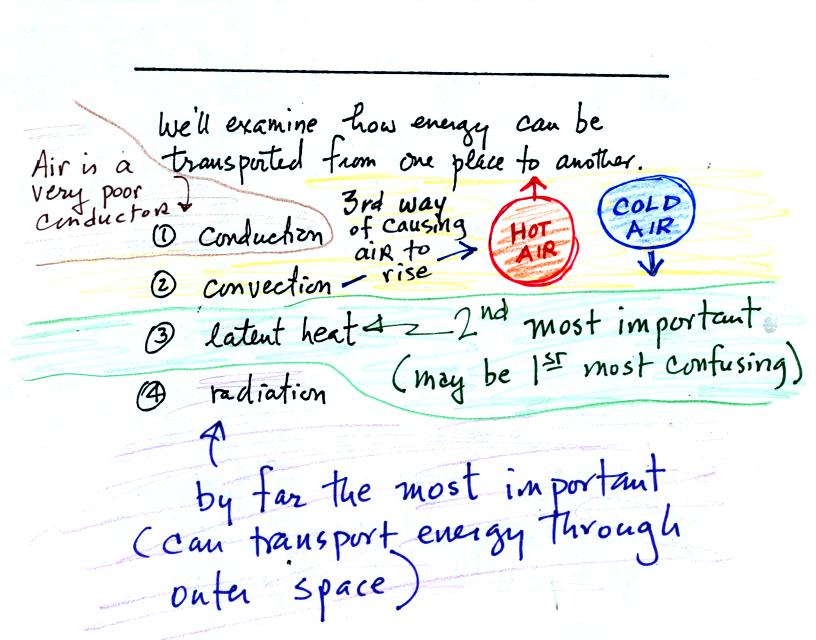
By far the
most important process is electromagnetic radiation (light is a common
form of electromagnetic radiation). This is the
only process that can transport energy through empty space.
Electromagnetic radiation is also responsible for about 80% of the
energy transported between the ground and atmosphere.
You might be
surprised to learn that latent heat is the second most important
transport process.
Rising parcels of warm air and sinking parcels of cold air are
examples of free convection. Because of convection you feel
colder or
a cold windy day than on a cold calm day.
Ocean currents are also an example of convection. Ocean currents
transport energy from the warm tropics to colder polar regions.
Note that convection is
a 3rd way of causing rising air motions in the atmosphere (convergence
into centers of low pressure, and fronts were the other two
ways). This is a topic we are really going to beat to
death. Archimedes law will also make an appearance when we cover
convection.
Conduction is the least important energy transport at least in the
atmosphere. Air is such a poor conductor of energy that it is
generally considered to be an insulator.
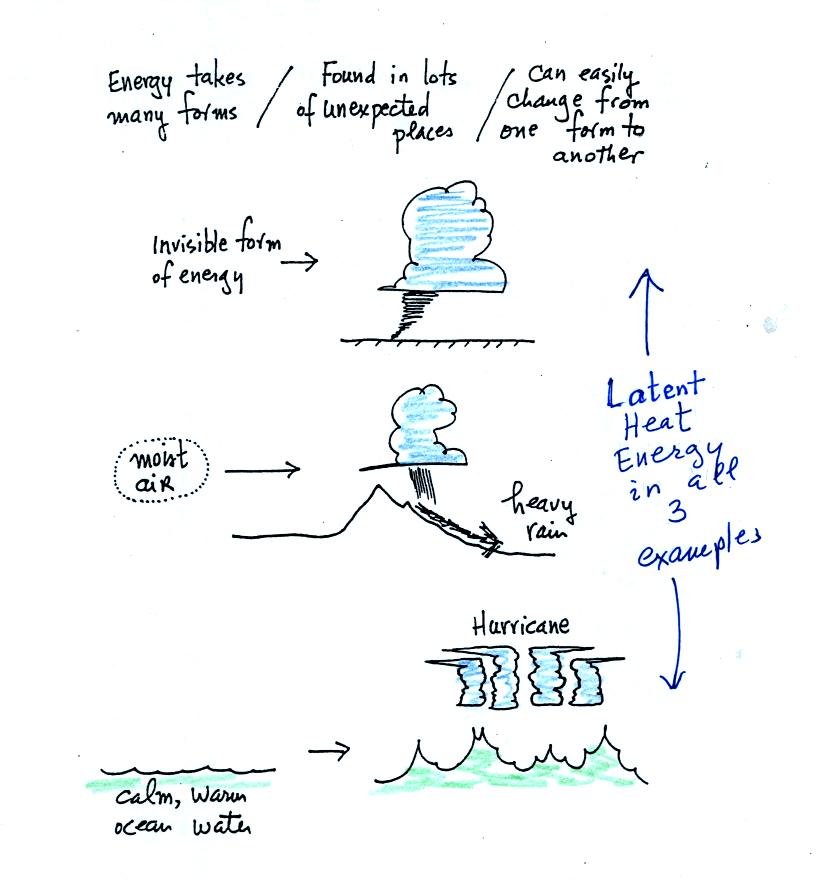
Water vapor is a particularly important form of invisible
energy.
When water vapor condenses to produce the water droplets (or ice
crystals) in a
cloud, an enormous amount of latent heat energy is released into the
atmosphere.
It is hard to visualize or appreciate the amount of energy released
into the
atmosphere during condensation. You can imagine the work that you
would do carrying a gallon of water
(8 pounds) from Tucson to the top of Mt. Lemmon. To
accomplish
the same thing Mother Nature must first evaporate the water and (if my
calculations are correct) that requires about 100 times the energy that
you would use to carry the 8 pounds of water to the summit of Mt.
Lemmon. And Mother Nature transports a lot more than just a
single gallon.
The next picture shows energy being transported from the sun to
the earth in the form of electromagnetic radiation.
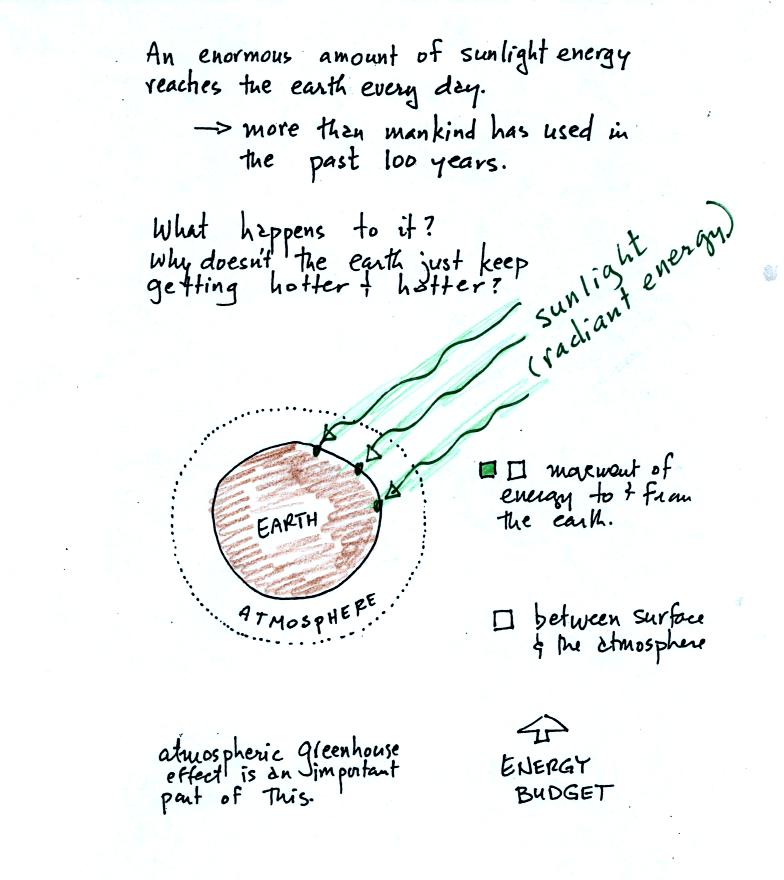
We are aware of this energy because we can see it (sunlight
also contains invisible forms of light) and feel it. With all of
this energy arriving at and
being
absorbed by the earth, what keeps the earth from getting hotter and
hotter? The answer is that the earth also sends energy back into
space (the orange and pink arrows in the figure below)
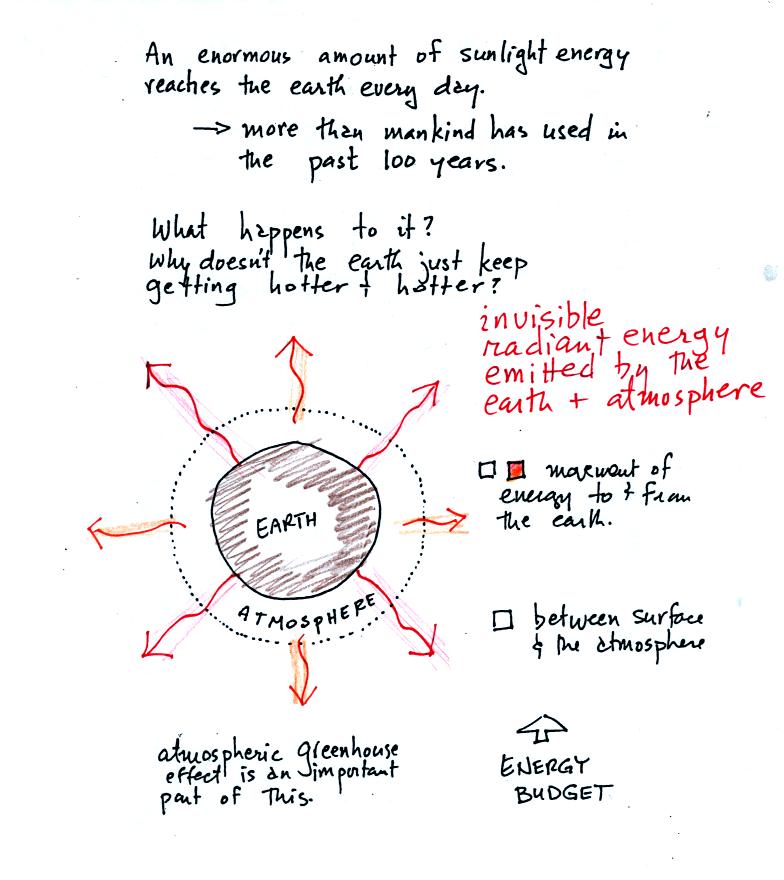
This infrared light is an
invisible form of energy (it is weak enough that we
don't usually feel it either). A balance
between incoming and outgoing energy is achieved and the earth's annual
average temperature remains constant.
We will also look closely at energy transport between the earth's
surface and the atmosphere. This is where latent heat energy transport
and convection and conduction operate (they can't outside
the atmosphere into outer space).
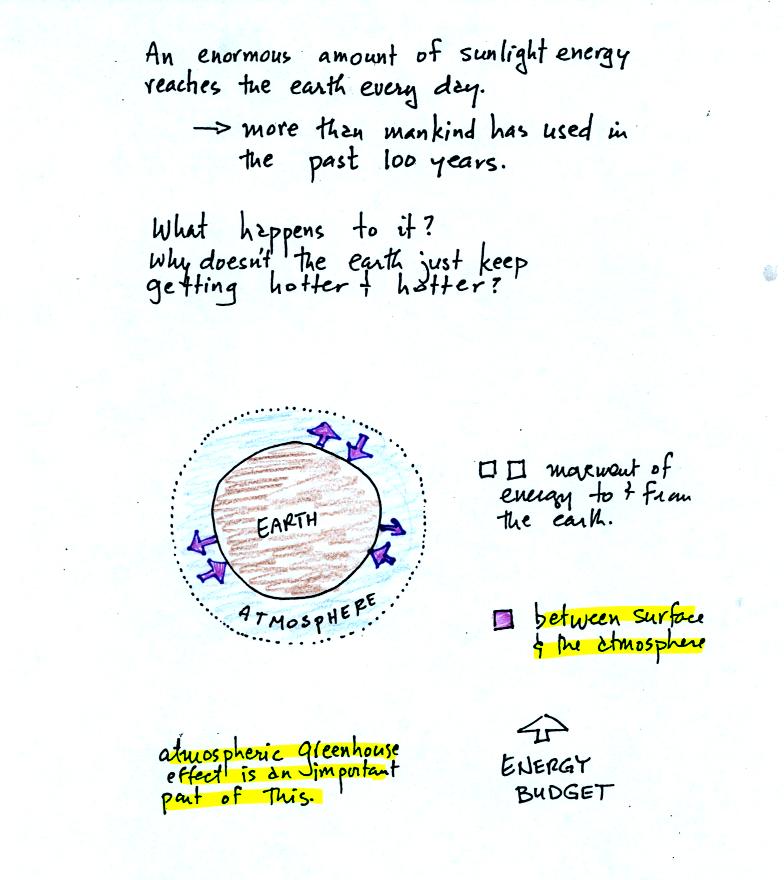
That is also where the atmospheric
greenhouse operates. That will be a important goal in Chapter 2 -
to
better understand how the atmospheric greenhouse effect works.
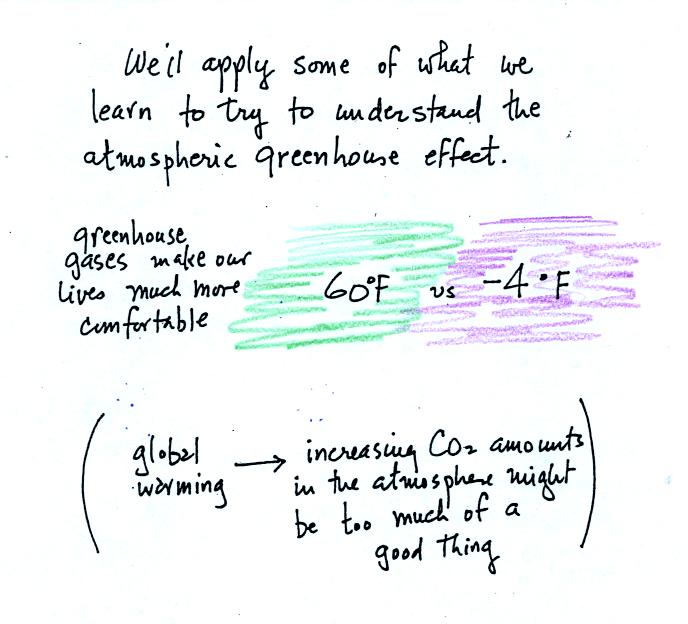
Remember that without the greenhouse effect, the global annual
average surface temperature on the earth would be about 0o F
rather
than 60o F.
Now we're
ready to start covering some of the material in Chapter 2. We'll
start on p. 45 in the photocopied Classnotes.
When you
add energy to an object, the object will usually
warm
up (conversely when you take energy from an object the object will
cool). It is relatively easy to come up with an equation that
allows
you to figure out what the temperature change will be.
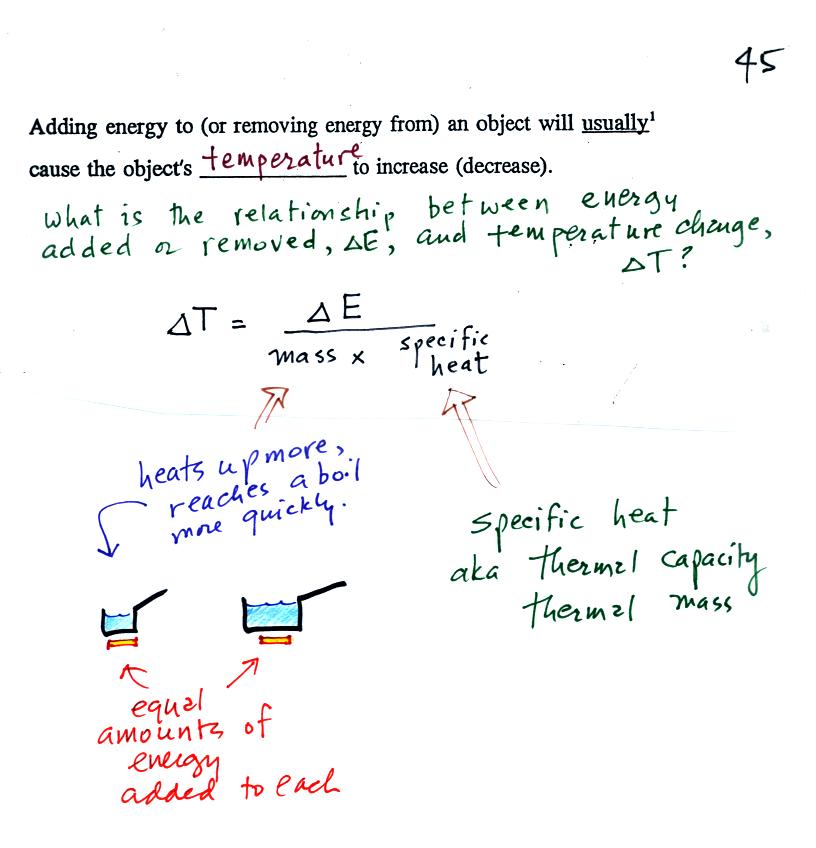
The temperature change will
first depend on
how much energy was added. This is a direct proportionality, so
delta E is in the numerator of the
equation.
When you add equal amounts of energy to a small pan of
water and to a large pan of water, the small pan will heat up more
quickly. The temperature change, delta T, will depend on the
mass. A large mass will mean a small delta T, so mass should go
in the denominator of the equation.
Different materials
react differently when energy is added to them. A material with a
large specific heat will warm more slowly than a material with a small
specific heat. Specific heat behaves in the same kind of way as
mass. Specific heat is sometimes called "thermal mass" or
"thermal capacity."
Here's an important example that will show the effect of specific heat.
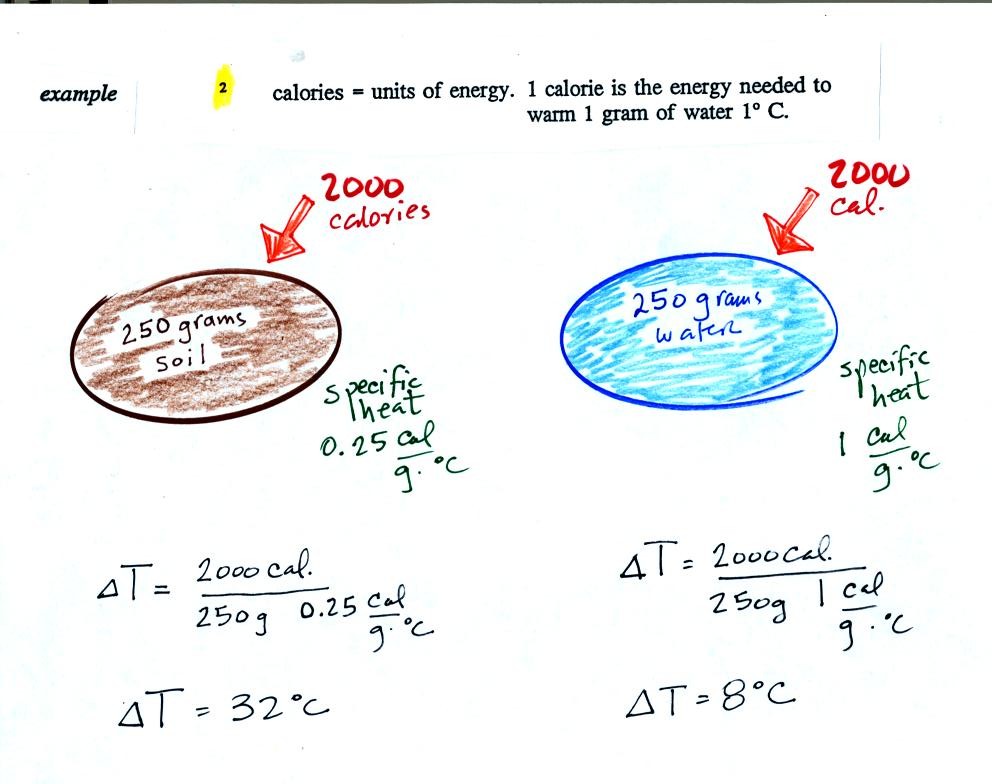
Equal
amounts of energy (note that calories are units of energy) are added to
equal masses of water and dirt. We use water and dirt in the
example because most of the earth's surface is either water or dirt.
Water has a higher specific heat than soil, it only warms up 8o
C.
The soil has a lower specific heat and warms up 32o C, 4
times more
than the water.
These different rates of warming of water and soil have
important
climate implications.
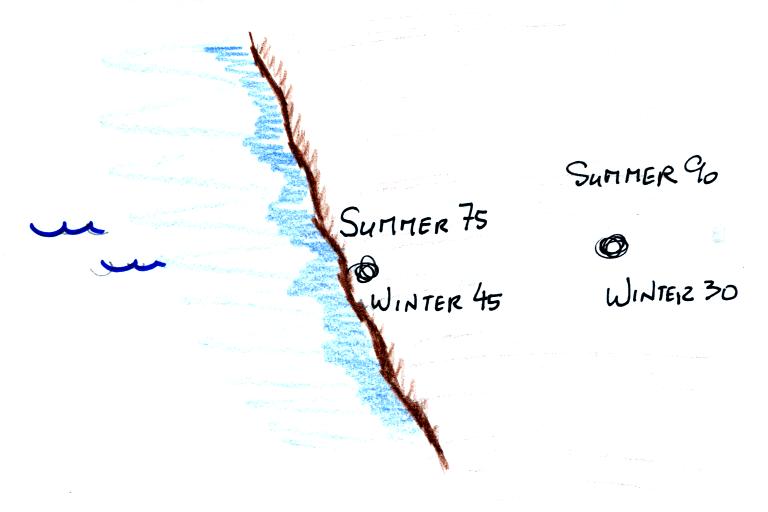
Oceans moderate the climate. Cities near a large body
of water won't warm as much in the summer and won't cool as much during
the winter compared to a city that is surrounded by land.
The city above on the
coast has a 30o F annual range of temperature. The
city further
inland (assumed to be at the same latitude and altitude) has an annual
range of 60o F. Note that both cities have the same 60o
F annual
mean temperature.
Adding
energy to an object will usually cause it to warm. But there
is another possibility, the object could change phase (change
from solid to liquid or
gas). Adding energy to ice might cause
the
ice to melt. Adding energy to water could cause it to evaporate.
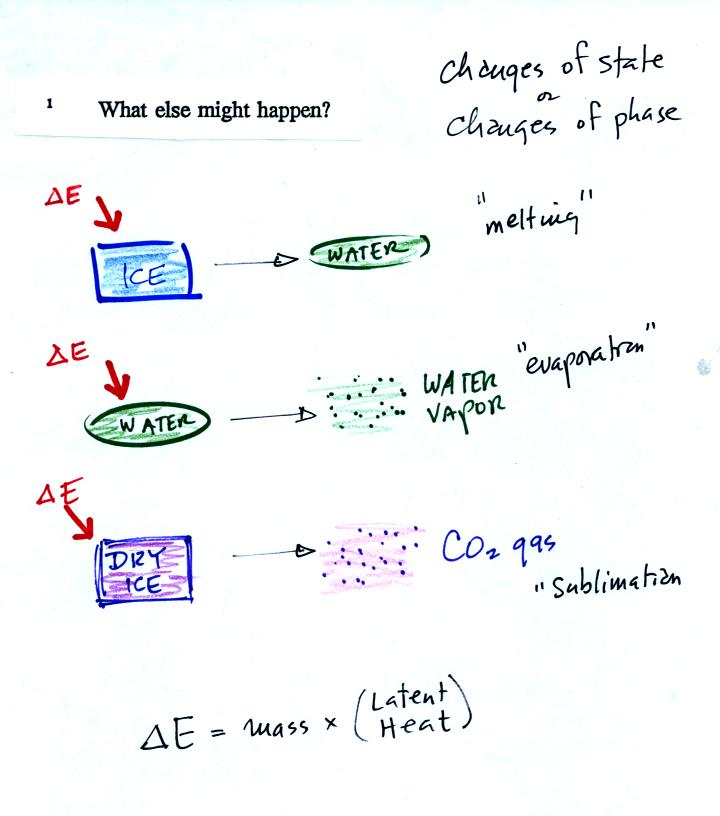
The equation at the bottom of the figure above allows you to
calculate how much energy is required to melt ice or evaporate water or
sublimate dry ice. You multiply the mass by the latent heat, a
variable that depends on the particular material that is changing
phase. We used this equation in an experiment conducted at the
end of class. We'll also use the equation relating delta T and
delta E that we discussed earlier.
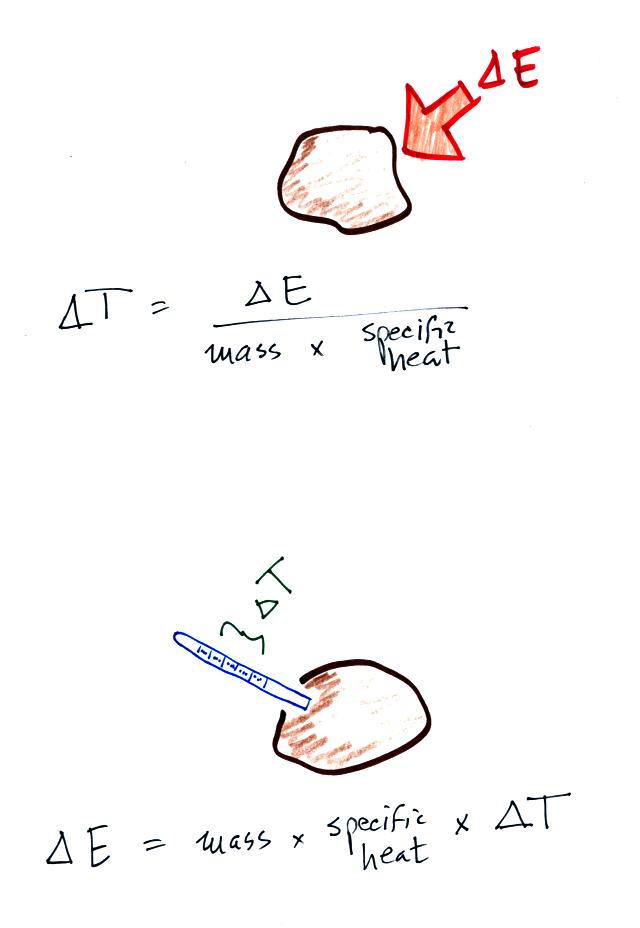
Rather than trying to calculate delta T (top figure) we are going to
measure temperature change, delta T, and use the second equation
(bottom figure) to measure energy flow.
The object of the experiment was to
measure the latent heat of
vaporization of liquid nitrogen. That just means measuring the
amount of energy needed to evaporate a gram of liquid nitrogen.
The students that are doing Experiment #2 are measuring the latent heat
of fusion of ice, the energy needed to melt one gram of ice.
You'll find the following figure on p. 45a in the photocopied
Classnotes.
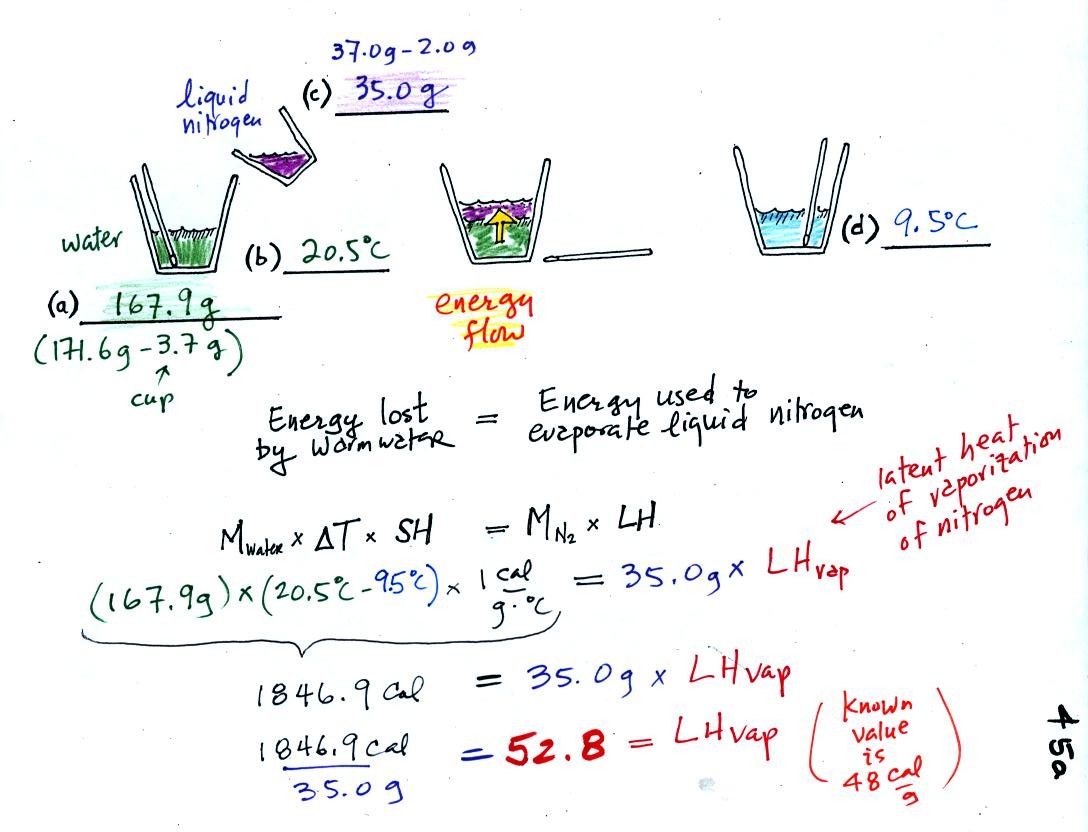
(a)
Some room temperature water poured into a styrofoam cup weighed 171.6
g. The cup itself weighed 3.7 g, so we have 167.9 g of water.
(b)
The water's temperature was 20.5o C.
(c)
35.0 g of liquid nitrogen was poured into the cup of water.
It takes energy to turn liquid nitrogen into nitrogen gas.
The needed energy came from the water. This flow of energy is
shown in the middle figure above. We assumed that because the
experiment is performed in a styrofoam cup that there is no energy
flowing between the water in the cup and the surounding air.
(d)
After the liquid nitrogen had evaporated we remeasured the water's
temperature. It had dropped to 9.5o C. That is a
temperature drop of 11o C.
Because we knew how
much water we started with, its temperature drop, and water's specific
heat we can calculate how much
energy was taken from the water. That is the 1846.9 calorie
figure above. This was used to evaporate 35.0 grams of liquid
nitrogen. So we divided 1846.9 calories by 35 grams to get 52.8
calories needed per gram. That is our
measured value of the latent heat of vaporization of nitrogen.
As trustworthy gentleman at the back of the classroom informed us that
the known value is 48 cal/g, so our measurement
was fairly close.
The
following material wasn't covered in class on Friday. If
you
carefully read through this material you'll find a link to a hidden
optional (extra credit) assignment that you can download, print,
and
turn in at the beginning of class on Monday.
When you add energy to an object and the object warms, what exactly is
happening inside the object?
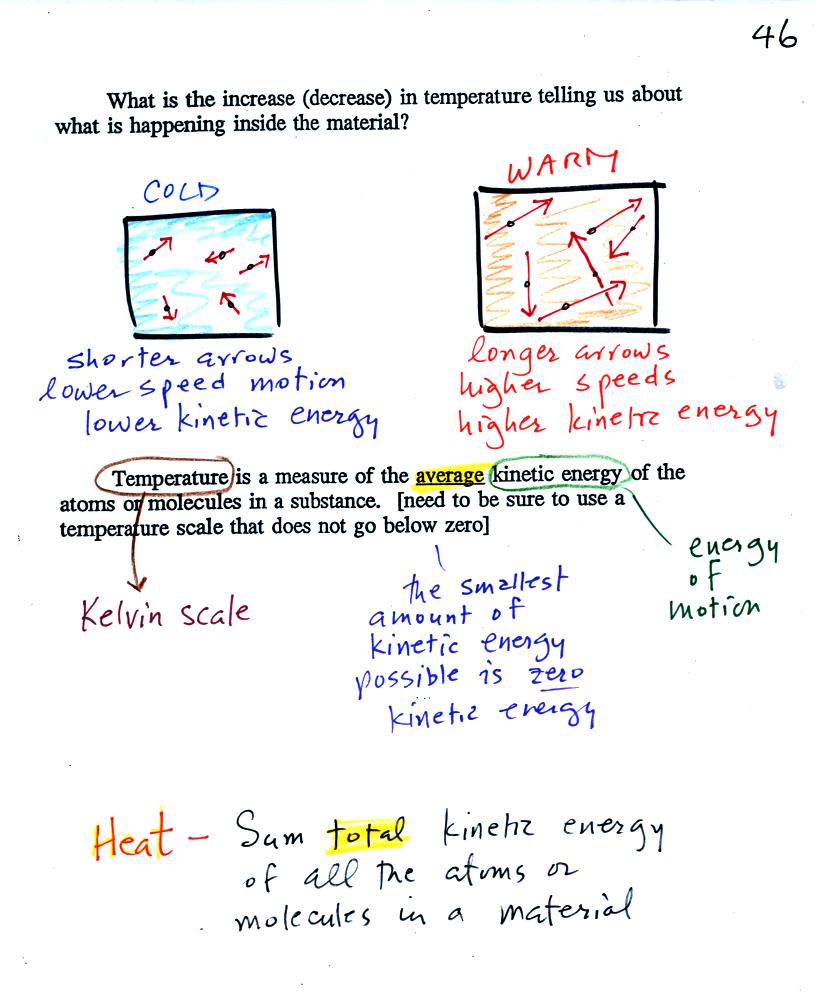
The figure above is on p. 46 in the photocopied Class
Notes. Temperature provides a measure of the average kinetic of the
atoms or
molecules in a material. The atoms or molecules in a cold
material will be moving more slowly than the atoms or molecules in a
warmer object.
You can think of heat as being the total kinetic energy of all
the
molecules or atoms in a material.
The next figure might make the distinction between temperature (average
kinetic energy) and heat (total kinetic energy) clearer.
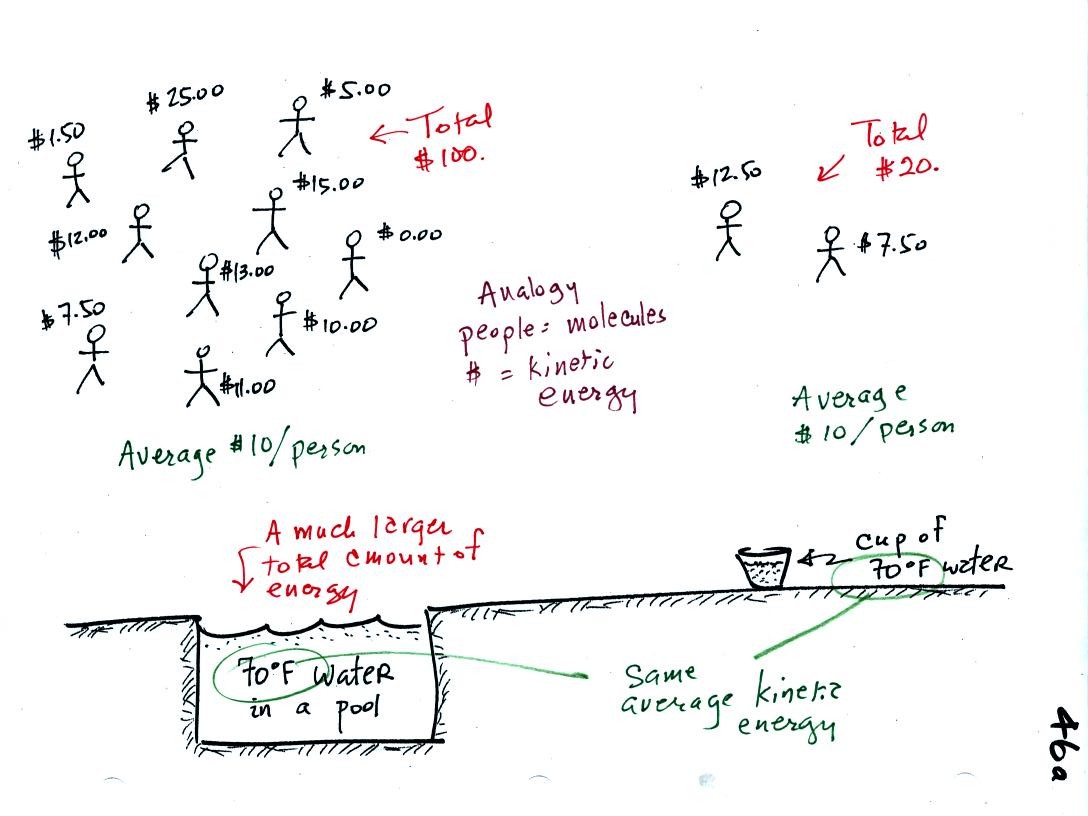
A cup of water and a pool of water both have the same
temperature. The average kinetic energy of the water molecules in
the pool and in the cup are the same. There are a lot more
molecules in the pool than in the cup. So if you add together all
the kinetic
energies of all the molecules in the pool you are going to get a much
bigger number than if you sum the kinetic energies of the molecules in
the cup. There is
a lot more stored energy in the pool than in the cup. It would be
a lot harder to cool (or warm) all the water in the pool than it would
be the cup.
In the same way the two groups of people shown have the same average
amount
of money per person. The $100 held by the larger group at the
left is
greater than the $20 total possessed by the smaller group of people on
the right. This is a good spot to hide the link to the hidden optional
assignment.
You need to be careful what temperature scale you use when using
temperature as a measure of average kinetic energy. You must
use the Kelvin temperature scale because it does not go
below zero (0o K is known as absolute zero). The smallest kinetic
energy you can have is zero
kinetic energy. There is no such thing as negative kinetic energy.
Speaking
of temperature scales.
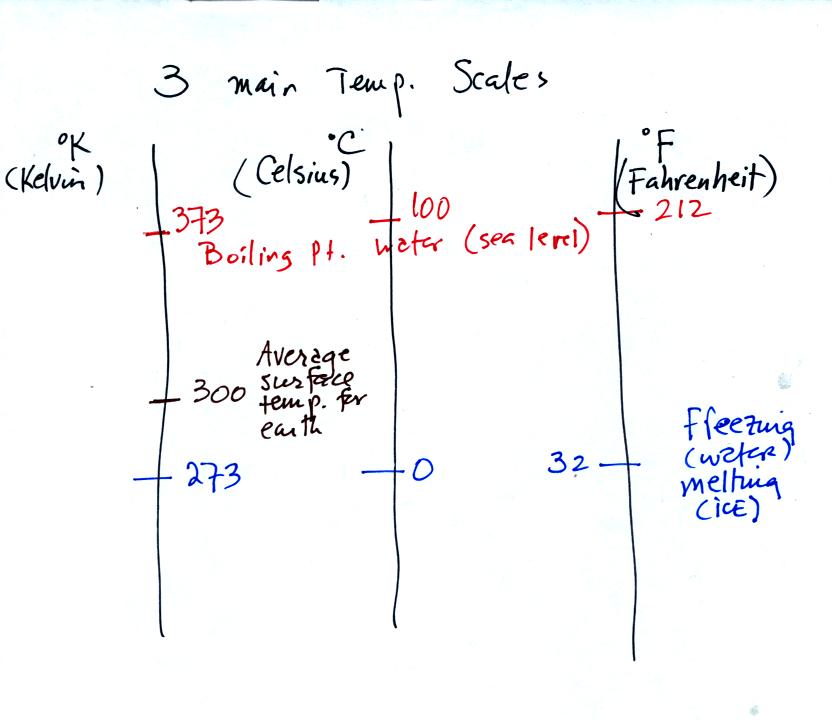
You should remember the temperatures of the boiling point
and freezing
point of water on the Fahrenheit, Celsius, and Kelvin scales. 300
K is a
good easy-to-remember value for the global annual average surface
temperature of the earth.
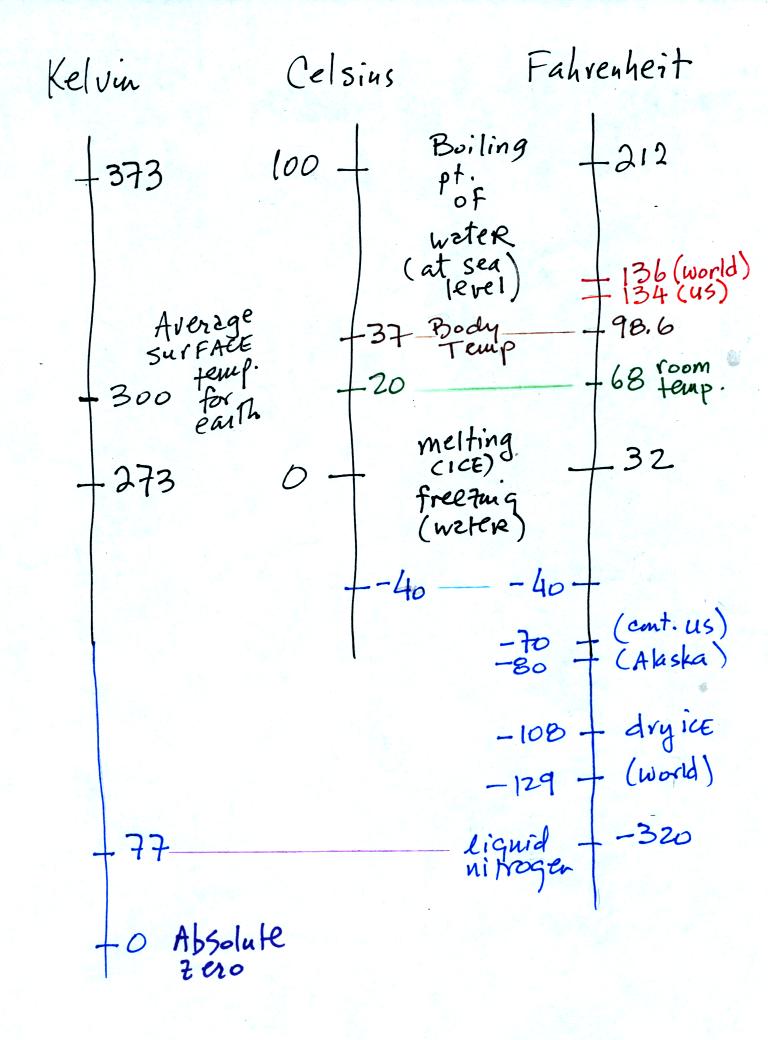
You certainly don't need to try to remember all these
numbers. The world high temperature record was set in Libya, the
US
record in
Death Valley. The continental US cold temperature record of -70 F
was set in Montana and the -80 F value in Alaska. The world
record -129 F was measured at Vostok station in Antarctica. This
unusually cold reading was the result of three factors: high latitude,
high altitude, and location in the middle of land rather than being
near or
surrounded by ocean. You'll find more record high and low
temperature data on p. 58 and p. 61 in Chapter 3 of the text.
Precipitation records are shown on p. 358. Note that even liquid
nitrogen is still quite a bit warmer than absolute zero.
















